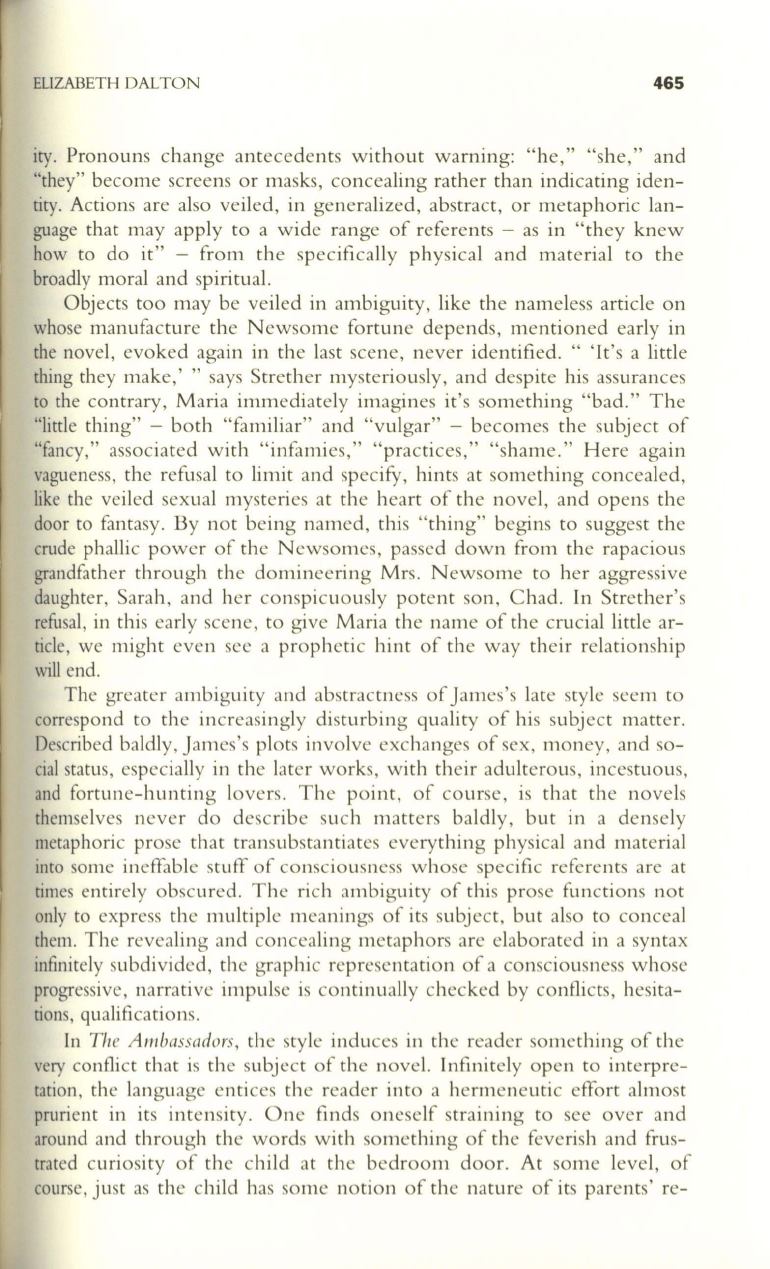
ELIZABETH DALTON
465
ity. Pronouns change antecedents without warning: "he," "she," and
"they" become screens or masks, concealing rather than indicating iden–
tity. Actions are also veiled, in generalized, abstract, or metaphoric lan–
guage that may apply to a wide range of referents - as in "they knew
how to do it" - from the specifically physical and material to the
broadly moral and spiritual.
Objects too may be veiled in ambiguity, like the nameless article on
whose manufacture the Newsome fortune depends, mentioned early in
the novel, evoked again in the last scene, never identified. " 'It's a little
thing they make,' " says Strether mysteriously, and despite his assurances
to the contrary, Maria immediately imagines it's something "bad." The
"little thing" - both "familiar" and "vulgar" - becomes the subject of
"fancy," associated with "infamies," "practices," "shame." Here again
vagueness, the refusal to limit and specifY, hints at something concealed,
like the veiled sexual mysteries at the heart of the novel, and opens the
door to fantasy. By not being named, this "thing" begins to suggest the
crude phallic power of the Newsomes, passed down from the rapacious
grandfather through the domineering Mrs. Newsome to her aggressive
daughter, Sarah, and her conspicuously potent son, Chad. In Strether's
refusal, in this early scene, to give Maria the name of the crucial little ar–
ticle, we might even see a prophetic hint of the way their relationship
will
end.
The greater ambiguity and abstractness of James's late style seem to
correspond to the increasingly disturbing quality of his subject matter.
Described baldly, James's plots involve exchanges of sex, money, and so–
cial status, especially in the later works, with their adulterous, incestuous,
and fortune-hunting lovers. The point, of course, is that the novels
themselves never do describe such matters baldly, but in a densely
metaphoric prose that transubstantiates everything physical and material
into some ineffable stuff of consciousness whose specific referents are at
times entirely obscured. The rich ambiguity of this prose functions not
only to express the multiple meanings of its subject, but also to conceal
them. The revealing and concealing metaphors are elaborated in a syntax
infinitely subdivided, the graphic representation of a consciousness whose
progressive, narrative impulse is continually checked by conflicts, hesita–
tions, qualifications.
In
The Ambassadors,
the style induces in the reader something of the
very conflict that is the subject of the novel. Infinitely open to interpre–
tation, the language entices the reader into a hermeneutic effort almost
prurient in its intensity. One finds oneself straining to see over and
around and through the words with something of the feverish and frus–
trated curiosity of the child at the bedroom door. At some level, of
course, just as the child has some notion of the nature of its parents' re-


